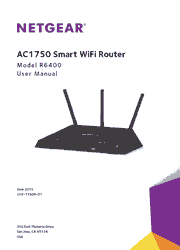Improve your WiFi speed and reliability with this AC1750 Smart WiFi Router, delivering speeds up to 1750Mbps. With poweful antennas and Beamforming+, this router offers the range and performance you need for large homes. Connect devices like Smart TVs and game consoles to the ultra-fast Gigabit Ethernet ports or connect a USB hard drive to one of two USB ports to create networked storage.
1. Hardware Setup
Unpack Your Router
Extend the Antennas
Top and Front Panels
Rear Panel
Position Your Router
Cable Your Router
2. Connect to the Network and Access the Router
Connect to the Network
Types of Logins
Use an Internet Browser to Access the Router
Change the Language
Access the Router with the NETGEAR genie App
3. Specify Your Internet Settings
Use the Internet Setup Wizard
Manually Set Up the Internet Connection
Specify IPv6 Internet Connections
Change the MTU Size
Enable the Bridge or Add a VLAN Tag Group
4. Optimize Performance
Prioritize Internet Traffic with Quality of Service
Optimize Internet Gaming with Upstream QoS
Add Upstream QoS Rules
Optimize Video Streaming with Downstream QoS
Improve Network Connections with Universal Plug and Play
Wi-Fi Multimedia Quality of Service
5. Control Access to the Internet
Set Up Parental Controls
Block Access to Your Network
Use Keywords to Block Internet Sites
Block Services from the Internet
Schedule When to Block Internet Sites and Services
Avoid Blocking on a Trusted Computer
Set Up Security Event Email Notifications
6. Share USB Storage Devices Attached to the Router
USB Storage Device Requirements
Access a USB Storage Device on the Network
Back Up Windows Computers with ReadySHARE Vault
Back Up Mac Computers with Time Machine
Control Access to the USB Drive
Use FTP Within the Network
View or Change Network Folders on a USB Drive
Add a Network Folder on a USB Drive
Edit a Network Folder on a USB Drive
Safely Remove a USB Drive
7. Access the Router’s USB Drive Through the Internet
Access the USB Drive Through the Internet
Dynamic DNS
Your Personal FTP Server
Set Up Your Personal FTP Server
8. Use the Router as a Media Server
Specify ReadyDLNA Media Server Settings
Play Music from a USB Drive with iTunes Server
Play Media from a USB Drive on TiVo
9. Share a USB Printer
Install the Printer Driver and Cable the Printer
Download the ReadySHARE Printer Utility
Install the ReadySHARE Printer Utility
Use the Shared Printer
View or Change the Status of a Printer
Use the Scan Feature of a Multifunction USB Printer
Change NETGEAR USB Control Center Settings
10. Specify Network Settings
Disable LED Blinking or Turn Off LEDs
View the WAN Settings
Set Up a Default DMZ Server
Change the Router¡¯s Device Name
Change the LAN TCP/IP Settings
Specify the IP Addresses That the Router Assigns
Disable the DHCP Server Feature in the Router
Manage Reserves LAN IP Addresses
Use the WPS Wizard for WiFi Connections
Specify Basic WiFi Settings
Change the WiFi Security Option
Set Up a Guest Network
How the Router Manages WiFi Clients
Control the Wireless Radios
Set Up a Wireless Schedule
Specify WPS Settings
Set Up the Router with an Existing Router or Gateway
Use the Router as a Wireless Access Point
Set Up the Router in Bridge Mode
11. Manage Your Network
Update the Router Firmware
Change the admin Password
Recover the admin Password
View Router Status
View and Manage Logs of Router Activity
Monitor Internet Traffic
Create Custom Static Routes
View Devices Currently on the Network
Manage the Router Configuration File
Remote Management
Remotely Access Your Router Using the genie App
12. Use VPN to Access Your Network
Set Up a VPN Connection
Specify VPN Service in the Router
Install OpenVPN Software on Your Computer
Use VPN to Access the Router’s USB Drive and Media
Use VPN to Access Your Internet Service at Home
13. Specify Internet Port Settings
Set Up Port Forwarding to a Local Server
Set Up Port Triggering
14. Troubleshooting
Quick Tips
Troubleshoot with the LEDs
Cannot Log In to the Router
Cannot Access the Internet
Changes Not Saved
Wireless Connectivity
Troubleshoot Your Network Using the Ping Utility
A. Supplemental Information
Factory Settings
Technical Specifications
